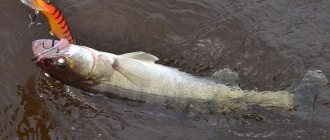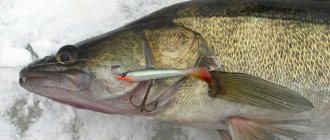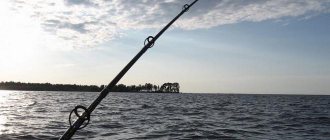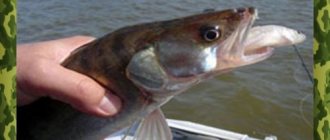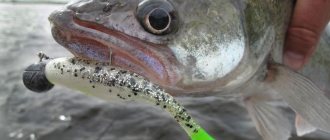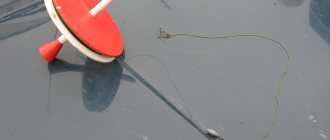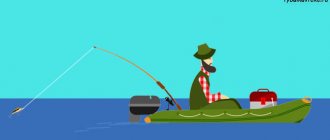To successfully troll for large pike perch in the Lower Volga, you need to have a suitable trolling boat with a motor and special gear, skillfully search for predator sites, know the most catchy pike perch wobblers, feel their game and be able to correctly present the bait to the “fangster”, and also imagine the biting schedule for this fish.
Article by Vladimir Polovinkin “5 PRINCIPLES OF TROPHY TROLLING Pike-perch”, written together with Viktor Andreev (full version). A shortened version of “FIVE PRINCIPLES OF SUCCESSFUL TROPHY TROLLING” was published in the magazine “FISHER-ELITE No. 2-2016”.
V. Polovinkin: 5 PRINCIPLES OF TROPHY TROLLING Pike-perch
Once at one of the fishing festivals in a friendly company of trollers, after a long and heated discussion of various nuances, everyone was asked a basic but “global” question: “What are the 5 main rules of successful trophy trolling?”
Oddly enough, none of the dozen trolling fans could answer the “childish” question right away, including me. But, after thinking carefully, I identified and prioritized my 5 principles of trophy trolling.
Let me clarify right away that by trophy fishing I mean targeted fishing for large (from 3 kg) pike perch in the vastness of the Lower Volga and Akhtuba - this is my “strong point”, to which I devote 80% of my trolling time. It is the seasoned “fanged” one that is the most enviable and prestigious prey for most avid fishermen. And it is precisely in the Volga expanses that there are still quite a lot of pike perch. And although pike, perch and catfish are often the prey here, my love forever is pike perch. Anyone who understands me will probably find my 5 principles of trophy trolling useful.
Principle 1 - CORRECT MATERIAL
Boat and motor
It is clear that almost always fishing for large pike perch involves vast river expanses with great depths and accompanying weather conditions that can change in just an hour or two. A piercing strong wind, a steep wave, rain (snow, hail) and other potential troubles in deep water make you seriously think about your own safety. Plus, with age, a habit of certain conveniences appears, which becomes increasingly difficult to give up.
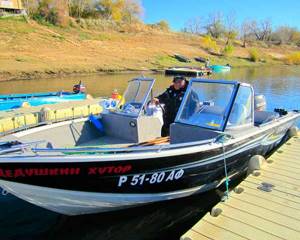
This means that for trolling on the Volga you need a more or less decent boat and the appropriate equipment. The boat does not have to be huge and clumsy, but it must provide ease of fishing, safety and the necessary comfort. Most inveterate trollers agree that a modern stable and well-handled boat 4.5-5.0 m long with a 60-70 hp engine. – what you need for big water. And even better is 5.0 -5.5m with a 90-115 hp engine. And I completely agree with them.
I would especially like to note the stability and controllability of the vessel, including at low speed. As it turned out, almost all modern boats “fly” well, but not everyone can quietly walk strictly along the edge, without getting knocked back and forth by the wind and waves - and this is precisely what is primarily important for the correct fishing of pike perch.
Agree, here the entire fishing process absolutely depends on the movement of the boat - and it is the correct movement that guarantees stable play of the bait in any conditions and its correct delivery to the right point - right under the pike perch’s nose. In this case, the medical axiom “movement is life” is completely suitable for our fishing. Ideal leisurely movement - ideal conditions for fishing. This means that the main priority of a trolling boat is a smooth, stable ride at low speeds. “Like an iron – always slow and straight,” joke avid trollers. And this will not be hindered by either wind, waves, bow or side motion, or random sudden movements of the helmsman. Well, since you still need to get to the catching places, a quick exit to the glider and a good cruising speed are also desirable.
It’s a pity that no one yet makes boats specifically for trolling. As practice has shown, often “beautiful” models are not stable enough at low speed, and therefore are not ideal for trolling. But many American boats (Starcraft, Alumаkraft…) showed their best side.

But a boat without a motor is like a cart without a horse. Therefore, the motor is no less important than the boat, and more correctly, they together should form an “ideal pair” for trolling. After all, only with such interaction is a stable play of the bait and its correct delivery to the desired point guaranteed.
With the motor power, everything is more or less clear - each boat, according to its carrying capacity, is suitable for a certain range of motor power. But this is again from a standard point of view - at a minimum, the motor should quickly bring the loaded boat onto the glider and drag it at cruising speed, and at maximum, the boat will “fly”...
But when trolling, most of the movement is low speed, and here the right motor must work stably and at the same time save fuel. After all, in a day of fishing, up to 100 liters of gasoline burns up - in modern times it’s far from cheap. However, no one produces special trolling motors, although now there are models that work quite stably at low speed.
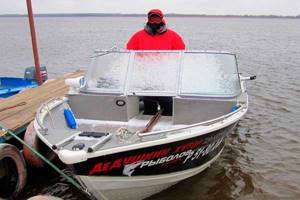
For example, when trolling, my navigator shows a speed against the current of only 3.0... 3.5 km/h, and along the current - 5.5... 6.5 km/h (it can’t be less). To ensure stable sailing of the boat at such a low speed and at the same time save fuel, you need to select a propeller with an optimal, slightly increased pitch.
It’s no secret that when sold, motors are usually equipped with a so-called “break-in” screw (step 19) - this option is good for break-in at medium speed. If you continue to use this propeller, then when you add gas to the maximum, the propeller “threats” in vain - the speed increases slightly, but fuel consumption increases noticeably. And at low speed the motion is also unstable: the boat twitches and yaws, which means there is no correct supply of the bait.
The solution is simple: after running in, install a propeller with a medium pitch (21) - this “golden mean” gives the optimal balance of speed, power and stability. If something doesn’t work out, we individually select a propeller with an optimal pitch for our “boat-motor” pair. Now we are guaranteed “sustainable” trolling. Which means there will be fish too!
There is an opinion that you can install 2 motors on a boat - a running motor and a low-power trolling motor - I cannot agree with it. Perhaps for long-distance crossings (Ladoga, Onega, sea bays) this makes sense.
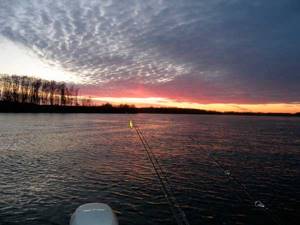
But for the Volga, where everything is more or less nearby, a second motor is not needed, here the minuses outweigh the pros: adaptation of two motors, difficulty in controlling at low speed (the small motor works “straight”, the big one “steers”), overload and asymmetry of the stern, “ double" exploitation - as a result, "the game is not worth the candle."
Everything said about the boat and motor should not be taken literally - this is rather an ideal option, and, alas, not everyone can afford it. Of course, you can, in principle, fish on any safe boats - but the overall result will be worse.
And, in my opinion, a very important point - you should have an experienced, like-minded partner in the boat. Together it’s more fun, more efficient, and safer. It is difficult to control the boat and fully fish at the same time - a friend will always help you quickly reel out the tackle, and hook up a huge handsome fish, and take a memorable photo, and who knows what... But the main thing is that the partner literally has his hands free - when retrieving, he can “play along” with the rod (which will be discussed later), and this often increases the catch significantly.
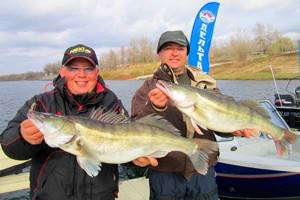
Equipment and tackle
To search for fish on a boat, a good echo sounder is required: now options with a structure scan are becoming especially popular - it is believed that they “see” up to 60% of the fish directly near the bottom, while a conventional echo sounder – only 20%. This is especially important for searching for pike perch, which often literally “stick” to the bottom.
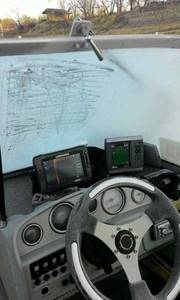
I always have 2 landing nets on my boat – one conventionally large and one conventionally huge. Large - for pike perch, huge - for catfish and record pikes, which sometimes “fly in” together with fanged ones. And to miss out on a record-breaking (albeit unplanned) catch because it didn’t fit or even jumped out of the landing net (pike are masters of such feints) – oh-oh-oh, what a shame! Moreover, when there was one moment left before the record and the prey was almost in hand... It was... Almost... Eh!
It is useful to weight the landing net with a weight of up to 300g at the end so that it quickly sinks during the current. This is especially true for boats with high sides - then you can effectively, like a shovel, pick up the prey in one movement and lift it on board. Gotcha, handsome!
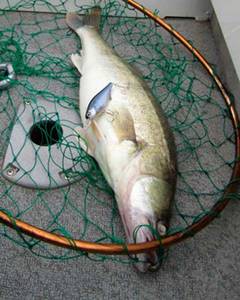
My friends and I fish with only 2-3 spinning rods. According to our practice, the second spinning rod increases the catch by 100%, the third – by another 50%. It is much more convenient for two people to work with two or three rods. And most importantly, when a predator “comes out” in a short area, you can quickly reel in the gear, turn around and quickly return to the run - here’s another confident bite!
In addition, two or three spinning rods allow you to quickly alternate baits and find what fanged gourmets like today.
I use spinning rods with a length of 260-280 cm, with a handle of medium length - these are more convenient, if possible, to catch while standing and to pull out fish (rest the handle on your stomach and “pump”). Rod tests for different wobblers are different - up to 30g, up to 40g and up to 60g. Accordingly, the braid costs different everywhere - with a tensile strength of 5-6 kg, 7-8 kg and 9-11 kg. This “spread” allows you to improvise: if you need to move a catchy bait higher, I take a spinning rod with thicker braid, and vice versa. A convenient multi-color cord, for example SUNLINE and GAMAKATSU, in which colors alternate every 10 m - it is convenient to control the release.
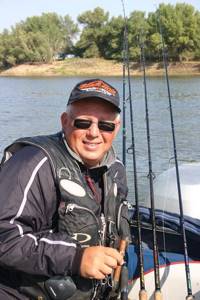
Reels are basically any inertia-free traction coils. A leash is desirable, but not so much for the fish, but to preserve the “wear resistance” of the cord, the lower part of which wears out very quickly and may not hold up at the most crucial moment. You can fish without a leash - then every day it is advisable to cut off the lower meter and a half of the cord. But most trollers use fluorocarbon leaders with a diameter of 0.3 - 0.4 mm; usually the strength of such a leader is enough for several days of active fishing.
Requirements for the craft
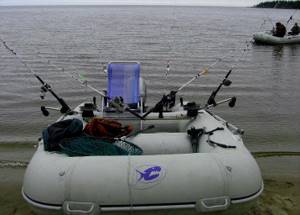
So, about trolling boats. What should they be:
- Boat. The most comfortable boat. For the most part, the boats are well seaworthy and allow you to load a large number of things. The only negative is the weight and dimensions.
- Inflatable motor boat. Its feature is mobility. Boats made of PVC material are compact. Models with a keel are quite stable on the water. Inflatable boats are relatively easy to maintain and more affordable. The running dimensions of the trolling vessel are 3.5-4 meters.
Motor: Today, most use foreign-made motors. Operation is simple, maintenance is not annoying. When purchasing a motor, you need to remember that the internal combustion engine has four strokes and is quieter than a two-stroke engine. Its fuel consumption is lower, but the engine itself is slightly more massive than a two-stroke and the price is higher.
On a note! If you don’t walk far on water, you can use power units with a capacity of 2-5 l/hp. If you plan to move 7-10 km from the anchorage, it is better to use a powerful engine that can bring the ship to planing in any weather.
On a PCV boat with two passengers, a motor with a power of 8-15 horses is often installed. This set is considered universal.
For trolling in small bodies of water, it is convenient to use a compact electric motor. The boat under it moves almost silently, which allows you to quietly approach promising places.
Recommended reading: Perch in the wilderness
Principle 2: CORRECT CHOICE OF FISHING PLACE – LOOKING FOR THE “BREAK” OF THE CURRENT
So, we have everything we need - we swim out to the pond. Fish - where are you? The echo sounder is turned on, but there is not enough time to search for pike perch by continuous combing. First, you need to evaluate the reservoir based on external signs and find its promising places. How?
My practice shows that most often pike perch bites in those areas where the current noticeably changes (“breaks”) either in direction or speed. The task is to find such a “break” in the flow.
Moreover, we are talking here not only about the underwater edges that are familiar to us - as a rule, a flatter drop closer to the shore is more promising and convenient for trolling. And it is along such relatively clean sandy dumps that the main fishing takes place in the Lower Volga. And here it is important for us to find the boundary between fast and relatively quiet (slow) water. After all, usually flocks of whitefish stand and feed precisely on such a “borderland” - but not everywhere, but in some local areas. And if somewhere nearby there is also an underwater snag, this almost guarantees the presence of pike perch.

Theoretically, you can find a “catching” area by the pattern of the water surface - the boundary of the streams always creates turbulence in the water and a combination of surface and ripples - an experienced fisherman knows how to read such traces. However, alas, you can’t outwardly determine whether there are fish here? Moreover, a troller does not need a separate catchable “point”, but a fairly long section (“run”). And here you can’t do without a good echo sounder, as well as some experience.
Method 1. We are looking for a steep, washed-out bank...
Our experience shows that on the Akhtuba and Volga tributaries, first of all, the pike-perch “Eldorado” should be looked for along steep, washed-out banks. Fresh collapses show that here the underwater stream “hits” straight into the shore, after which it sharply changes direction, forming “lulls” and “returns”, where flocks of whitefish constantly graze - here they have food and a home. And most importantly, fallen trees and debris form an underwater snag along the shore - an excellent shelter for fanged animals, from where they, like wolves from the forest, raid the nearest “pastures”.

A control passage along the shore with an echo sounder at two depths (usually 4-6m and 6-8m) shows: there is whitewash, there are snags near the shore, there are pike perch, the area is suitable for fishing - a rare coincidence of all factors almost guarantees successful fishing. Such areas sometimes remain for several years, delighting with stable catches, but often in the next season they are “washed out”, lose the desired relief and stop working. Alas, happiness is not endless...
Method 2. Looking for a “jump” in the current
Unfortunately, the first method is too obvious and “primitive” - there are few such obvious places, and everyone knows about them. And it is applicable only on relatively small “relief” rivers. But on the Volga itself, although there are no sharp turns in the channel, there are suitable extended drops, and quite a few - but not all of them “work”. Therefore, the “hidden” method is more complex and interesting - we look for a “jump” in the jet. What it is?
It has been noted many times that at depth, pike perch bite sites are very often associated with local accelerations or decelerations of the current. Moreover, this may not be noticeable visually, but the navigator impartially shows that the boat’s speed has arbitrarily “jumped” from the set 3.5 km/h to 4.0 km/h. Or vice versa – up to 3.0 km/h. You understand that some kind of interaction of underwater jets occurred below, caused by anomalies in the nearby bottom topography. If you examine the “surroundings” in detail with an echo sounder, you almost always find something interesting - underwater holes, mounds, ditches, etc. These are good places for an ambush. Where else, if not here, seasoned hunters will wait for their prey. And we will definitely come across...

If such a “jump” in the current is found (and more than one), and the points are entered into the navigator, quantitative fishing turns into qualitative fishing. That is, instead of a long continuous run (usually 30-40 minutes), one or several short local passes of 5-10 minutes are made - the catch and emotions are twice or three times greater! A striking example: the famous Volga run near Dzhamba - with a length of about 1 km, where most trollers fish, in recent years I have been fishing in an area of only 200 m, because 80% of the bites were there! The reason is about the speed of the jet. In other words, not the entire seemingly suitable “run” works, but only the place with a “break” in the flow.
But a “jump” in the current is observed not only at depth, but also in shallower places. Why? In many sandy areas, the river bottom resembles a desert - dunes, dunes, ridges... And all this slowly shifts and changes under the influence of either the wind - in the desert, or the current - in the river. But, unlike the wind, the current always washes longitudinal ditches in the underwater sand “dunes”, which attract both peaceful and predatory fish - this is a kind of tray through which food is “supplied”. It’s enough to swim there with your mouth open... Or wait at the end, when the food from the “tray” falls directly onto the “table”.
Moreover, in an echo sounder, a promising area may not be noticed, because the longitudinal depth in the “ditch” changes little (as in a gorge between mountains), but it is in the “ditch” that the flow noticeably accelerates, and at the exit it slows down, which can be seen on the “speedometer” navigator. Another promising site has been found! True, such bottom sandy ditches are short-lived and usually quickly washed away or washed away by the current, but they are always there somewhere - which means we will definitely have a few happy moments!
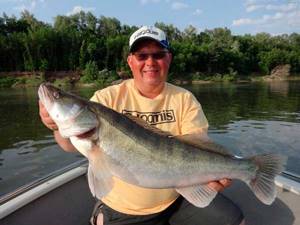
Method 3. Looking for clusters of white fish
Often schools of pike perch simply graze large schools of whitefish and migrate after prey without being tied to local points. Therefore, any large “spot” detected by an echo sounder is a reason to linger. And if the structure scanner also shows the presence of pike perch, everything is perfect, a good day awaits us. Or maybe tomorrow the flock will not be far away.
We’ve decided – there’s a break in the current, there’s whitefish, the echo sounder shows – there’s pike perch – how and with what to get them?
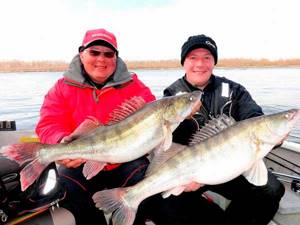
Principle 3: CHOOSING THE RIGHT LURE AND UNDERSTANDING ITS PLAY
First - the favorites!
So, we swam out to deep water and found a suitable place: there is a break in the current, there is whitewater, the echo sounder shows that there are pike perch - the question is, how and with what to take them?
Almost always, the basis for the choice is the food motivation of the pike perch: what kind of fish it is currently feeding on - the color, size and action of the bait, as well as the speed of the retrieve are selected according to this main prey.
True, with color, not everything is so simple - practically experienced pike-perch fishermen in the Lower Volga have wobblers of natural colors on average only 25% of their working arsenal. And the lion's share of 60% are various yellow-green baits, and the remaining 15% are red and dark wobblers.

You can’t argue with practice - it has already been confirmed many times that the favorite color of the Volga-Akhtuba pike perch is yellow-green. You can try to explain this by various reasons: the local color of the water, the peculiarities of the color perception of the fanged one, its increased aggressiveness, the pack pattern of hunting when a specific target stands out... Or you can simply take it as an axiom: the FT (Fight Tiger) color is the first and main one, which we “launch” on pike perch. The second color is just natural; here most of the fish are caught on light pearl wobblers, including RH (Red Head). The third priority is dark colors: it often shoots either in the summer in general, or in the morning and evening in any season. I especially like the RDT (Red Tiger), bright red with black stripes.
But with the size of the wobbler it’s the other way around - no “old merits”, everything is selected anew each time “in place” and “in time”. This fish, pike perch, is such a picky fish.
What does this look like in practice? Let, for example, an echo sounder show pike perch at depths of 5-6m. For this depth, I already have proven “favorites” - these are the 9-centimeter RAPALA Shad Rap-9 and RAPALA Trolls To Minnow-15, as well as smaller wobblers: TSURIBITO Deep Shaker 75F and TSURIBITO Super Crank 60 DR, plus a reserve large version of BANDIT Deep Walleye 12 cm. From this working five, I usually choose a pair with a mid-frequency game from RAPALA, but of different shapes (shad - minnow) - and start fishing. If there are no bites, during the second or reverse run (already downstream) I change the wobblers to a smaller, high-frequency pair from TSURIBITO, again with a different shape (more like a shad - crank) - and fish further. If there are still no bites, I also try a larger version of the 12 cm minnow from BANDIT with low-frequency play. With such different baits in all respects, you can relatively quickly find out what size, what shape and what game the pike perch likes today.
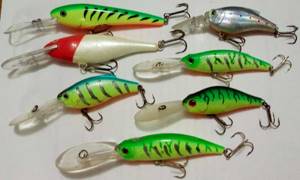
Another option is to immediately put different sizes 90 and 75 and change them to 90 and 60 cm on the return trip. Usually in spring and summer pike perch prefers smaller baits, in autumn - larger ones. But even here it doesn’t happen from day to day... If necessary, the wiring horizon of any wobbler can be raised or lowered using thicker or thinner braid.
And then, finally, the first bite, then another and another... After some time, you realize that today the size of the wobbler is better than such and such, and the game is such and such - you put baits from this series and then experiment with colors - in terms of illumination and according to my mood. Although color experiments are more “for the soul”, because in principle I do not like “monotonous” fishing and always try to experiment whenever possible.

There are always options
We can talk endlessly about wobblers, but I would like to especially note three interesting points:
- All wobblers are different. Even in the same package with the same wobblers, half can catch better, half worse. This is especially true for “handmade” baits - the blade is glued in slightly wrong, and the effect is no longer the same. It’s not for nothing that athletes select the best baits in a separate box - only for competitions.
- There are no universal wobblers. By universal I mean those wobblers that not only work stably at any real fishing speed, but also stably catch at any such speed. Alas, I know of only one model that is close to this ideal, but due to its small size, large pike perch often (except in early spring) ignore it - this is the ZIP BAITS B-Switcher 4.0.
- There are special wobblers - for example, the so-called marine series with white (anti-corrosion) hooks initially requires increased wiring speed, because in the sea the fish are more active and faster. Carrying such a wobbler at the usual “river” trolling speed is a waste of time, it simply does not give the desired game.
The conclusion from here is simple - since there are no universal wobblers, you have to use the “motor” to select your own optimal wiring speed for almost each model. That is why a motor that operates steadily (finely regulates speed) and is well controlled at low speed is so important.
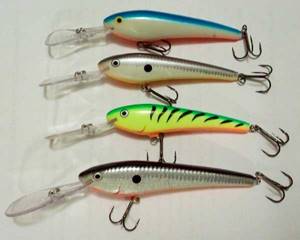
To support this, I will give a clear example. There are short periods when pike perch require high retrieve speeds. They are connected with the course of the Astrakhan herring. In May, the belly fish rises en masse upstream, and at the end of June-beginning of July, it also slides en masse into the sea. This very fast fish is a real delicacy for pike perch, therefore, during periods when the herring is moving, fanged ones “target” exclusively at it and react only to the high speed of feeding the bait - 5.0-5.5 km/h against the current.
The wobbler must be felt
As one famous spinning fisher said, “you need to feel the bait as if you were leading it with your hand.” I completely agree and I’ll even say more – this is no less important for trolling. Alas, 90% of trollers have serious problems with this.
I don’t encourage you to see through the water, but intuitively or from experience (shaking of the fishing line and the tip of the rod) to feel at what speed the bait plays best, to feel all the touches of the bottom, to notice a failure of the game due to debris on the blade of the wobbler - all this comes far from straightaway…
The problem for many is that they don’t feel it fully!
And we are not talking about easily “readable” wobblers here. Take any crank - the action of the bait is active, the tip is clearly shaking, the action is easy to “read” - everything seems to be normal. And if at the same time the wobbler still catches fish well – what more could you want?
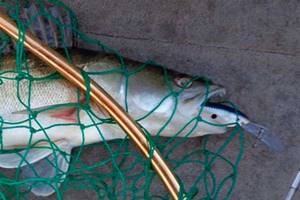
But then the predator became capricious - you have to look for another bait that is not so active... And the feeling of control disappears somewhere...
Remember - HALCO wobblers at the dawn of mass trolling were perhaps the most popular in the Lower Volga - all for the same “readable” reason. And I started with them. However, lately, it seems, predators have become accustomed to them - and I began to catch less, and so did the others. However, other catchy wobblers appeared, seriously displacing the “old shots”.
Now half of my lures are hard to read, including the RAPALA Shad Rap and TSURIBITO Deep Shaker. You need to “understand” these baits and get used to them, without being afraid of their unusual game. But when you study and feel their character and believe in them, the catches will go off scale.
For example, the “Sobolev Memorial” was won twice by trollers from “Delta” using a wobbler that is “cultivated” there - RAPALA Shad Rap 9. This is what it means to “understand” the bait.
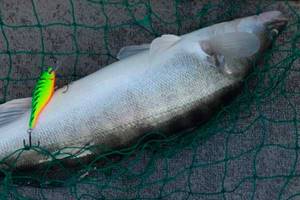
Or TSURIBITO Deep Shaker - a wobbler that has many “clones”, but all these copies with a little more active play are completely inferior to the original, seemingly with such inexpressive movements. And for pike perch this seems like the most exciting dance... So catch this fish, so catch this wobbler!
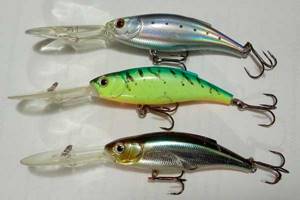
Principle 4: CORRECT SUPPLY OF BAIT
To plow or not to plow?
There is a popular phrase, “make an offer you can’t refuse.” Ideally for a troller, this means presenting the bait “on a silver platter” right under the pike perch’s very nose. That is, depending on where the fish is staying, apply the wobbler from the right direction, to the right depth and with the right action - then the predator will not resist.
“It was smooth on paper, but they forgot about the ravines...” And indeed, a good boat and a good wobbler are not enough here - you also need the vision and skill of a fisherman, which comes with experience. This means we have to learn: “we all learned a little, something and somehow...” - and there is no such master who was not once a beginner.
How to “present” a wobbler to pike perch correctly? My opinion is clear - when reeling, the wobbler should “plow the sand” or “knock on the bottom,” that is, it should almost constantly (every 1-2 seconds) and actively scratch along the bottom. At a depth of 4-6 m, technically this can be done without much difficulty. But at greater depths, due to the greater angle of attack and increased resistance of the braid, the wobbler bounces more strongly and cannot “dig” constantly - but it should “plow” at least 10-15 times it touches the bottom per minute.
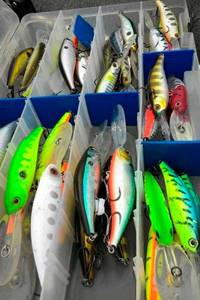
This is not just my principled opinion - it is entirely based on personal long-term experience. I had to go through the fear of “wasting wobblers,” which, fortunately, turned out to be exaggerated - but now bright bites and spectacular moments of fishing for record-breaking fanged ones constantly delight the memory.
With the flow
Although trolling against the current is considered “classic”, this does not mean that you cannot fish with the current. Not only is it possible, but often necessary!
Just one example is fishing in “ditches”. If the echo sounder shows accumulations of leucorrhoea at depths of 3 m, you should look for pike perch in the water. The fanged ones especially like to stand on sandy spits that protrude into the depths, where the current washes out peculiar ditches. If there is a school of pike perch in such a ditch, then they stand “on the current” (that is, with their heads against the current), with 1-2 of the largest fanged ones in front, medium-sized fish in the middle and smaller specimens in the back. If you “hand” the wobbler from behind (against the current), then the smallest rear pike perch will be the first to see it and react - it’s faster and easier for the lively “juniors” to turn around and grab the bait. If the wobbler approaches from the front (downstream), even at a higher speed, then the adults charged with attack will always be in time first (and perhaps the subordination in the flock does not allow the young to brazenly intercept the prey from under the noses of adult pike perch). And we are just looking for big fish!
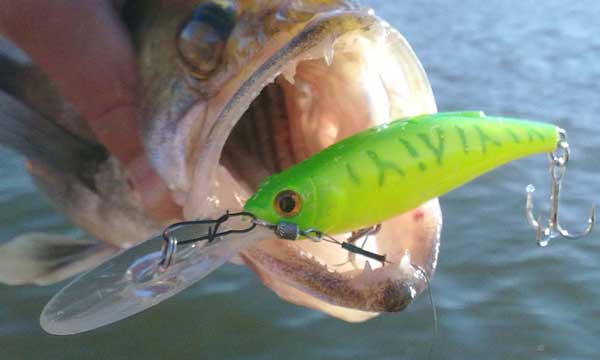
Another example is that fishing downstream with a high speed of retrieval is effective during periods when very nimble bellied herring are rolling down the river, and here a fast presentation is perhaps the main prerequisite for success.
Moreover, in both cases considered, the wobbler must actively “plow” the bottom - this, in my opinion, is the troller’s main trump card.
Play along
There are no rules without exceptions, and even the axiom “movement is life” can be questioned. Trolling is, in principle, straightforward and monotonous fishing. Our boat moves at a constant speed, and so does the bait... Although, as a beginner, I heard that pike perch are often more willing to take a wobbler at a stop, but how can I stop it? And then one day, at the end of a run on a sharp turn, the line with the wobbler sagged, the tip of the rod pulled back - as if the wobbler, having buried itself in the bottom for the last time, stopped and began to slowly float up. After a couple of seconds, I already began to reel in the tackle and on the very first turn of the reel (it seems that the pop-up wobbler stopped at that moment and “pecked”) I felt a ringing blow from the pike perch. Hooray! The theory was clearly confirmed by practice.
It is also possible to do such a feint with a stop during the run itself, especially in promising places. However, in this case, the speed of the boat is lost, the wiring is also lost, and the gear can get mixed up - therefore, in practice this technique is rarely used. And if pike perch bites well anyway, why bother? It is much easier, if a predator is capricious, to steer the boat on steep tacks in promising places - this way the necessary play along is obtained automatically.
But the most interesting option is when a partner free from the steering wheel plays along with a wobbler. So he quickly moved the rod horizontally to the side and immediately quickly returned it back, until he lost control and the braid sagged - at this time the wobbler, having plowed the bottom, after jumping forward, stops and begins to float up. Most often at this moment a distinct blow follows - yes! Gotcha!! I outsmarted you!!!
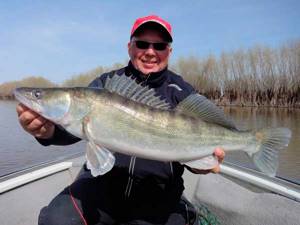
It is clear that the wobbler for playing along must be fast-floating, so that it can rise above the bottom in one or two seconds. The fisherman pauses until he regains control, and when the floating wobbler stops again due to the increasing tension of the fishing line and bites with his nose, at this moment a bite is likely again! Alas, this time it’s empty...
Again, a quick movement of the spinning rod to the side and back - and the cycle repeats. All this is very reminiscent of step-by-step bottom wiring in reverse - to ascent. But you must admit that it is more complicated than a regular jig “step.” And whoever says that this is unsportsmanlike, let him be the first to throw a stone at me.
The play along can be different in length, and the pause can be different in duration - it all depends on the speed, current, length of the rod, thickness of the braid and buoyancy of the wobbler... It's not easy, but it's worth it! Indeed, with the correct playing along, the conditional score “Player”: “Helmsman” can reach, for example, 10:2. Especially when the fish are capricious – that is, almost always!
Installation of tackle for trolling pike perch
As in general, gear for trolling must be durable, and even more so for catching pike perch. This is due to the bottom topography, where the fanged fish usually prefers to stay. And such places are often underwater ridges of stones, uneven and wavy areas of the bottom, snags that pike perch love. All this threatens the gear when hooked. In addition, pike perch has a stubborn character, resting on the bottom and difficult to fish out, especially if the pike perch is large. Adding the force of the current here, you can imagine the load the tackle is under. In addition, the wobblers themselves are not skinny minnows, but deep-sea large baits that themselves rest when entering the starting horizon, like strong fish. Therefore, rather short, fast-action rods are selected and equipped with multiplier reels, as they are the most durable and long-lasting when it comes to trolling. In addition, they usually have line counters, which allows you to drop the line and release the wobbler at a certain distance from the boat.
There are many devices that often help the wobbler achieve the desired depth if it itself cannot cope with the force of the current and is not able to sink to the bottom. And budget copies of catchy analogues often have such shortcomings. You can read in more detail about the ingenious mechanisms that move baits away from each other and deepen wobblers in this section.
The use of metal leashes when trolling for pike perch is a necessary necessity, despite the fact that this predator is very suspicious of these elements of equipment installation. But here there is a relatively reliable way to deceive a cautious predator with leashes made of modern materials, such as titanium and Kevlar, which are almost as flexible and thin as fishing line. However, these leash materials also have one very unpleasant drawback: during numerous attacks by predators, these leashes receive micro-scratches that are invisible at first glance, which, nevertheless, can one day affect the result of fishing for a large pike perch, that is , cause the leash to come off. And there is no other choice but to inspect the leashes and, if necessary, replace them. Or simply replace them after a certain period of time.
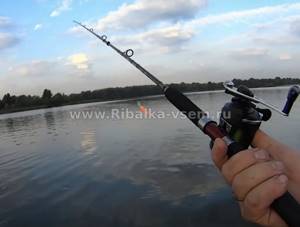
In addition to diving wobblers that reach certain levels in the water column and at the bottom, equipment is used, which is also called a drop shot, but this is rather fishing with a retractable leash, which is often the most effective in spinning fishing. The equipment consists of the simplest elements: the main fishing line with a pear-shaped or spherical end weight for better sliding along the bottom and a metal leash approximately 30-50 cm above the sinker. The leash is tied to a triple swivel so that the tackle is flexible and does not twist during movement. Some anglers are replacing the metal leader with a fluorocarbon leader. In addition, they use equipment that resembles a retractable leash, only this is a more rigid scheme, which is called a bouncer. Here the wobbler is mounted on a spring wire frame. In order not to complicate anything, we can limit ourselves to the definition that this is the same diverting leash, but the main fishing line from the sinker to the leash, 30-50 cm long, is replaced by a spring wire, like the leash itself. The principle of operation of such equipment is that the wobbler always moves near the bottom, skirting uneven surfaces, and does not require various deepeners. When installing equipment when monofilament fishing line is used, swivels should be installed on all nodes to avoid twisting of the equipment.
Principle 5 - CHOOSING THE CORRECT TIME OF FISHING
Even if we have fulfilled all the previous conditions, we may not catch pike perch. After all, this predator with its twilight vision - unlike perch and pike, which can take all daylight hours - feeds with a more strict frequency.
When you fish constantly, it’s clearly visible - sometimes it bites, sometimes it doesn’t bite. And if the fish is on a break, then no tricks will help. Therefore, it is very important to use those periods when fanged fish are most actively caught.
If you look at the seasons, then for Akhtuba and the Lower Volga we can distinguish three most “cool” periods:
1.Spring (early-mid-April) – with the first warming of the water and the onset of tolerable weather, migratory pike perch quickly rises and local ones become more active.
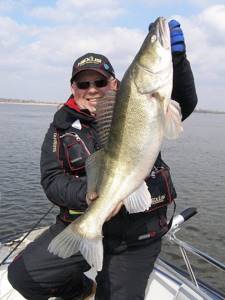
2. Summer (end of June-beginning of July) - the flood ends, the fry from the hollows and eriks rolls into the river, where the herring is waiting for it, and the pike perch is already “grazing” it - a haven for predators! And it’s comfortable for fishermen - midges are no longer an annoyance.
3. Autumn (mid-October-early November) – local pike perch become more active (as “belly” is coming), and the migratory fish gradually decline.

It is during these periods that you can count on truly record catches. The rest of the time, pike perch are caught with varying success.
If you look at the most “cool” hours, then (although, in principle, single pike perch were caught at any time), there are clearly characteristic daily peaks of biting depending on the season (data are averaged):
In spring, pike perch usually bites from 10 a.m. to 5 p.m. with varying success; cold water clearly displaces and stretches the bite.
In summer, as a rule, at dawn at 3:30 am, active biting begins until 7 o’clock, which gradually subsides by 10 o’clock. It doesn’t bite during the day, and the heat just doesn’t allow you to catch. From 18:00 to 20:00 – evening “out”.
In autumn, from dawn there is a pronounced long “breakfast” lasting 2-3 hours, then in the afternoon there is a short “lunch” at about 13-14 hours and, finally, an hour-long “dinner” at sunset.
Therefore, learn to adapt to the zander’s schedule - and you will always have a catch!

Choosing a trolling rod in the store
Regardless of the cost, your future trolling rod should be carefully inspected and tested in the store. An approximate set of simple tests that you can do in the store yourself looks like this: - inspect the surface of the fishing rod for the presence of peeling in the paintwork, cracks, chips; — we join the parts of the spinning rod (the landing couplings must connect smoothly and tightly, and do not rotate after joining); — we take the assembled spinning rod in our hand, swing it from side to side, and make several sharp swings. Defects in the rod may be indicated by squeaks, crackles, clicking sounds, or even knocking noises (defects in couplings); - carefully inspect the passage rings and the “tulip” (ring at the tip), pay attention to the anti-friction inserts in the rings - they should sit tightly in the seating sockets and not rotate. The type of packaging used by the manufacturer will also say a lot about the quality. As a rule, budget products are supplied in plastic film, mid-price fishing rods are packaged in a velvet or fabric case, and elite spinning rods are equipped with plastic tubes or cases. Pay attention to the presence of a manufacturer's warranty - this is an indicator that you are purchasing a high-quality, original product, and if the rod fails through no fault of yours, you will have a chance to replace the product or get your money back. A good, well-made fishing rod will withstand the load of a sudden hook and its condition will be excellent even after several fishing seasons. When hooking and landing a trophy predator, the fisherman does not have to rely on luck.
